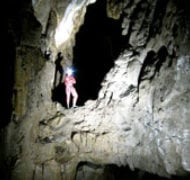Spelunking: A Lenten Reflection
Blog / Produced by The High Calling
For the first 200 feet or so past the entrance, daylight tumbles down into the corridor of boulders and forest debris. It makes the wet surfaces glisten. It’s dark enough to switch on our helmet-mounted headlamps but light enough that we can’t tell if they make a difference. Excitement and the stream below our feet make us raise our voices. We’re going caving.
The first right turn is a thin crevice that moves us away from the water and light. Ten eager bodies slip into it, shuffling and sidestepping over uneven stones, while the walls bump against us on both sides and occasionally pinch our helmets.
I come to an intersecting passageway – one of hundreds in this two-mile underground labyrinth – and my left boot runs out of ground. I look down and discover a five-foot drop. The step across is manageable, but getting into the hole on the other side (in a crawling position no less) without falling, poses a challenge.
I turn to tell the group what to do. Only no one except the person immediately behind me can see what I see. The space is simply too confined and the others have their own concerns. So I explain the situation to the woman behind me. Then I cross and she inches forward, avoiding the same fall I almost took, and warns the caver immediately behind her. Then she crosses and that caver instructs the man behind him. And so on. This is how we learn to trust the person in front of us and care for the one behind.
Forty five minutes of hallways, cracks, holes, slides and encouragement later, we arrive at a somewhat spacious cavern. It’s a surprising relief to see everyone at once. We discuss our experiences, drink from our drag bags, adjust the headlamps, and prepare for more challenges.
Since that initial drop crossing, we haven’t seen any outside light, though nobody realizes this yet. And we’re far enough into the maze that few would find their way out without significant help.
It’s difficult for me to not feel a sense of power here. If I were to take their lights and disappear, the situation could become national news. But I’m a teacher, not a criminal, so I give a short lesson on the eastern pipistrelle bat.
We explore long into the afternoon, squeezing into smaller and smaller spaces like Keyhole which requires us to exhale to pass through; and Birthing Canal, a 70’ (that's feet) body-sized tube with one particularly frightening corner that can only be traversed by extending your arms in a diving position, lest you get stuck.
We also hop along stream beds and play on van-sized boulders. The group is gaining confidence.
A test
Eventually we come to a large, sloped rock in the lower end of the cave. It’s time for a test. They deposit their drag bags and follow me up a passageway, about 25 feet, to an intersection where I point back to the pile of gear. Their objective is simply to return to that location. The passage is tall enough to walk upright, and it’s a straight shot, though uneven and the walls come and go. Regardless, to all observers it appears to be a piece of cake.
That's when I take their lights.
Then I walk quickly back to the gear and turn off mine too. They’re on their own.
For the first time since the initial crevice, we can’t see a thing. The air is blacker than you've ever experienced black. Even after minutes of staring and squinting, the uneasy sense remains that our eyes have just disappeared. No sparkles on the calcite walls, no glimmer from headlamp lenses, no visible movements or shadows of any kind. Just pure, deep, blackness.
The cavers instinctively reach for each other. The ones with navigational confidence offer suggestions, while caregivers ask questions. They collaborate as a group for several minutes and appoint a leader. And then they begin what ought to be a ten-second stroll.
All day they've practiced trusting and caring for the partners immediately in front and behind, and this is exactly what they do now; only now it matters more. Progress is slow and by the second obstruction they question not only their position and direction, but also their elected guide. All nine respond differently. Many have new ideas. A few become silent. Others joke to relieve the tension. After more time and more failed attempts, frustration increases. Even a bit of fear creeps in.
I can hear them, of course. They’re relatively no closer or farther away than they were half an hour ago, despite traveling short distances in every direction. But that's the point of the exercise: they're lost. As this new reality becomes clear, they call for me. They know I wouldn’t desert them, but my silence and their tangible experience of disorientation – with friends whom they trust but who are also disoriented – unnerves them. They have absolutely no idea where they are.
From my quiet seat there on the dirt path, right beside the pile of drag bags and headlamps, I light a match. The tiny red surface explodes with life and illuminates the entire passage; not brightly, of course, but it so alters the darkness that everyone looks to it in relief, including me.
And that's what we remember about the cave.
Image by m0untainpenguin. Used by permission, via Flickr. Post written by Sam Van Eman.





